The Renewal Process
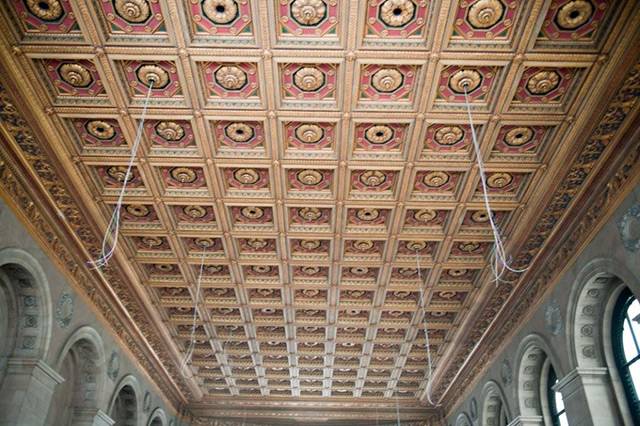
The eight chandeliers that have hung in the Great Hall for almost 100 years were removed to be restored and relamped with modern energy-efficient sources. New wiring and control systems have been installed throughout the building. This main floor required very careful lighting design to both illuminate the enormous, beautiful rooms and to provide a comfortable modern work environment for researchers and browsers.

Sophisticated, high-speed data networks have been made available in every room, including the historic rooms of the main floor. Here workers channeled the floor in the former Humanities Room to install accessible data conduits. This work needed to be done very carefully to protect Central's enormous floor load capacity - necessary to support the huge collections. These modern additions have been hidden beneath cork floor tiles, restored to their original 1912 pattern, and provide permanent, flexible data connections throughout Central, in addition to building-wide wireless networks.
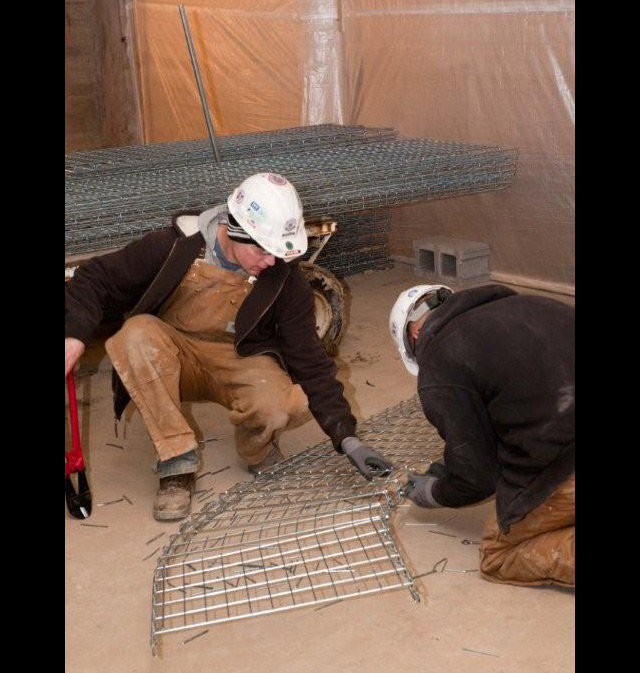
In basement and service areas, miles of fiber optic and copper data lines are carried in these open trays suspended from the ceilings. Technology changes so quickly that the Library must be able to adapt constantly.

On the 3rd floor, the heavy steel supports of the original design allowed the walls and ceilings of what once were the director’s office, business offices, and corridors to be removed, creating an enormous new public room: one of four entirely new public spaces on this floor alone. This picture shows workers installing heating and cooling equipment in the newly insulated attic space.
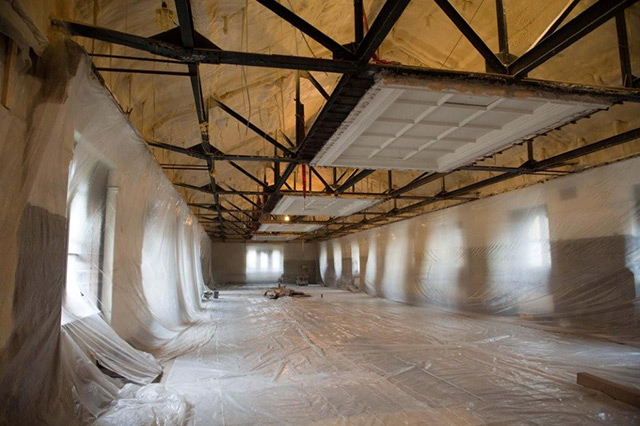
This enormous space once housed the Library's Technical Services department. The department - which buys, catalogs, and prepares thousands of books, magazines, DVDs, and other new items every month for all 17 locations - has been moved into less valuable office space across 14th street. The new Geneaology department will occupy this room. Here you can see new insulation throughout the original attic space, and the building's original 3rd floor skylights exposed.
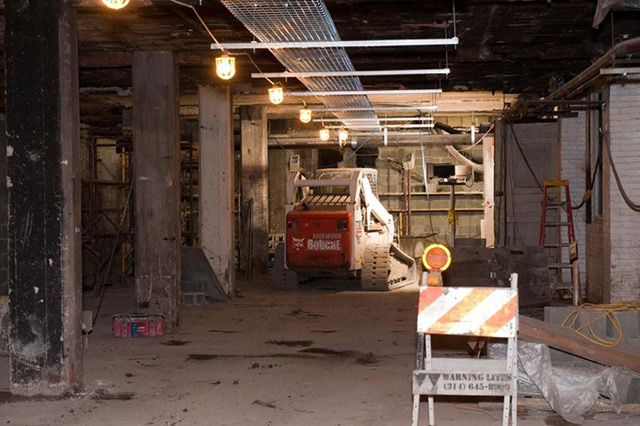
So much heavy work was going on in the basement that BSI Constructors brought machines as large as this Bobcat inside by driving them down the original delivery ramp and tunnel.
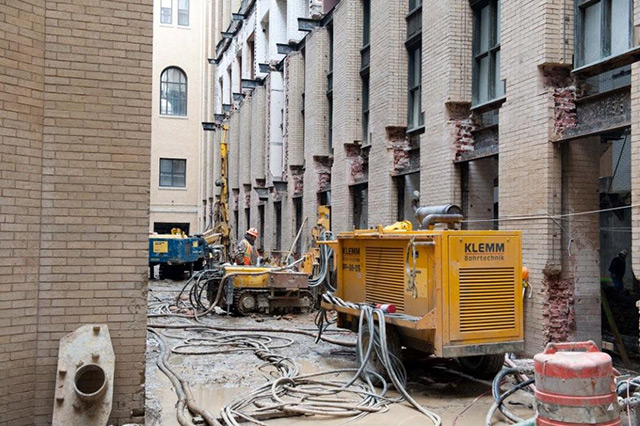
In Central Library's courtyard, the original staff bridges that connected the main building to the stack tower were surgically demolished and removed. New connecting structures, housing elevators, restrooms, and other service areas, have been rebuilt here without blocking the main windows. In the background, a drilling rig delicately drills another support for the new structure within the original foundations.
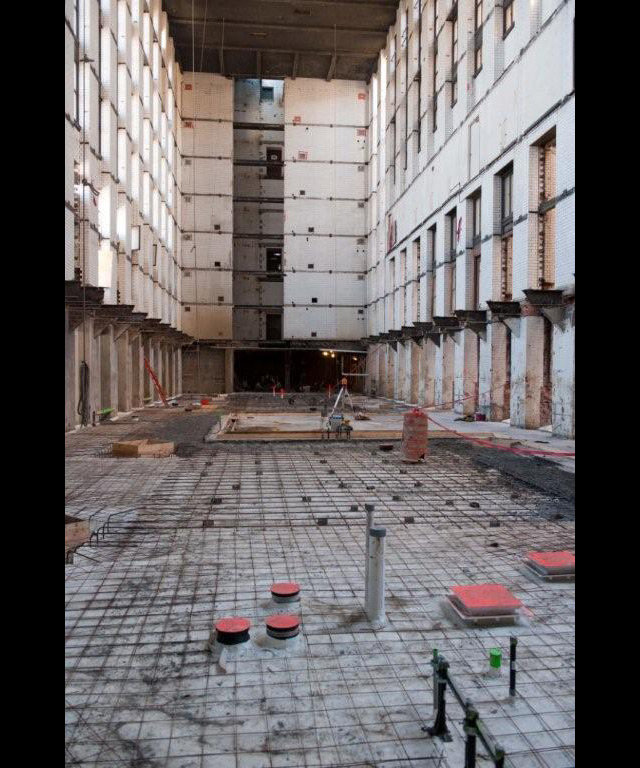
In this picture all of the new "micropile" foundations have been drilled to bedrock beneath the original stack tower, and a new concrete floor has been poured at the basement level. The entire interior of the stack tower is covered in beautiful white "subway" tile, which has been cleaned and has become the walls for the sleek, contemporary rooms that now fill this area. Although this massive volume of open space has now been filled in - as later pictures show - the floating, open character of the new rooms and atrium have made the stack tower clearly visible for the first time since it was built.
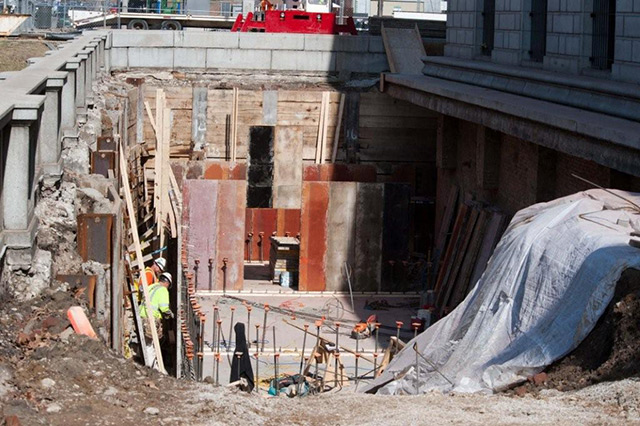
Passers-by on 14th Street may have wondered about the enormous excavation exposing Central's foundations. This is a "vault" that was built to hold new electrical equipment required by the utilities. The equipment was hidden underground to protect the views of Central Library's beautiful facades. Connecting to the basement meant cutting through concrete walls almost 2 feet thick.

By the end of March 2011 the electrical vault on the 14th Street side of the building was largely enclosed. This massive pit has been infilled and the terrace lawn now covers most of the structure, making it and the enormous transformers and other equipment invisible. The trap door remains at ground level so that the vault and equipment inside can be accessed.

This picture shows massive new steel framing being maneuvered carefully into place on the west end of the stack tower. These beams and columns were trucked through downtown and then slid through the existing window openings before being connected to the new micropile foundations underneath the original ones. The viewer here is standing in the new atrium space looking at a corner of the new café and a new training and meeting room above. The size of the steel is required to carry the enormous weight of the new compact shelving high in the original stack tower.

April 7, 2011. Some of the more delicate restoration work has begun outside the building. If you look carefully at the side of the building at the third floor level, the golden gleam you see is the reflection of new copper linings on top of the massive granite cornice that runs between the second and third floors (for years maintenance workers walked around the building on this ledge 40 feet above the granite pavers below.) Leaks in the original copper linings marred the granite wall carvings over the years, which were cleaned later in the restoration process.

In early April of 2011, massive truckloads of new steel beams and columns began arriving on site. The majority of this steel was used to create new structure within the shell of the original stack tower. Here a new beam is threaded carefully through the opening that has now become the main Locust Street entrance.

On April 19th, 2011, several activities are taking place outside Central Library. On the side of the building, construction workers are repairing the large concealed gutter that drains the tile outer roof. On the front, diamond-tipped tools are being used to remove any broken mortar from the very fine joints between the stonework. The mortar was carefully replaced to match the original and all of the stonework has been cleaned.

Also on April 19th, work was begun to reset the granite steps after the supporting structure was replaced. Each individual piece had to be located in the stockpile and set back into its original location. A few granite pieces that broke as the structure settled were replaced with new granite, also from Mt. Waldo. To the left of the workers replacing the granite pieces, the new concrete base rises two more flights, ready to be covered with more original granite. The change in grade from east to west made recreating the original staircase particularly tricky.

On the third floor, one original room was recreated alongside the four enormous new public spaces. The intrusions made over the years on the original Gallery have been removed, reopening it to its full size. The beautiful coved ceiling has been restored and the Gallery is now available as a large meeting and exhibit space, with connected restrooms and serving spaces. The skylight, inexplicably covered by florescent lights many years ago, has been restored and will once again light the room. Astonishingly, it is completely original, and has remained sound and watertight, hidden in the attic for a hundred years.
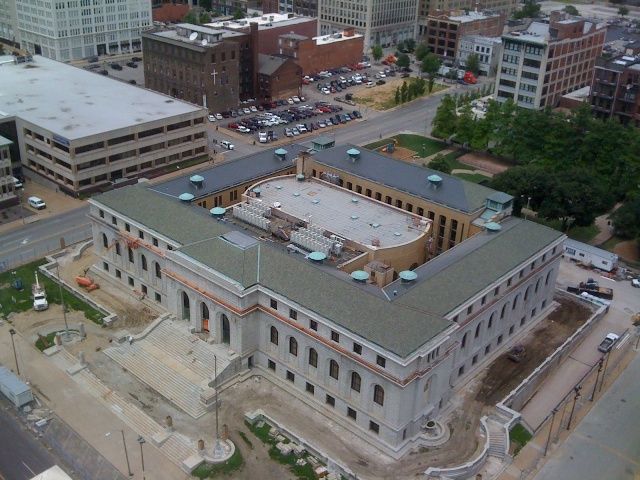
A bird’s-eye view (actually taken from the landmark Park Pacific building undergoing restoration across Olive Street) of the Central Library construction site, taken on April 20th, 2011. From this height, one can clearly see the secret of Gilbert's design, with the Great Hall actually being a freestanding oval tower (with the flat gray roof) built within the enormous hollow square of the building, and connected by bridges across the open courtyard. The original stack tower is the wing across the back of the building, on Locust Street. The large, modern building to the left, just across 14th Street, is owned by the Library. Administrative offices and support services were moved into this building to open up new public service space in Central Library.
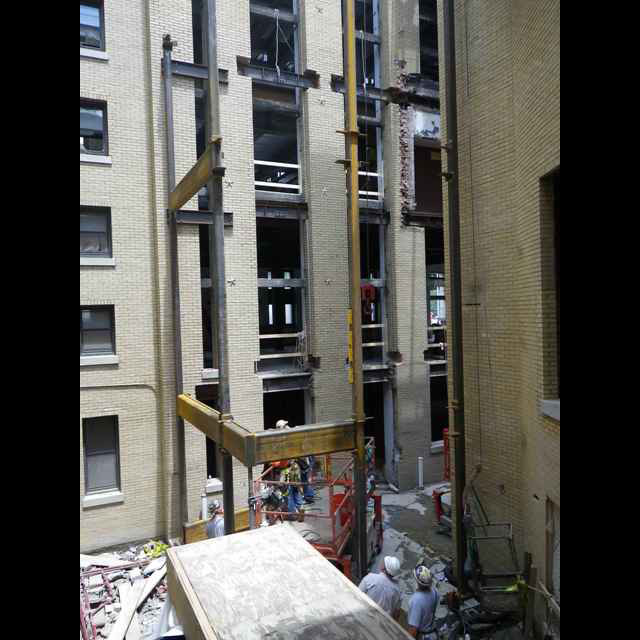
This photograph was taken in mid-June of 2011 in the courtyard - an area and view always screened from the public. To the right is the wall of the structure that houses the Great Hall, and ahead is the wall of the original stack tower. The steel frame being erected now occupies that space, and contains high-speed elevators connecting all the floors, as well as new restrooms on each floor. Enough space is left in this new structure to create conference rooms for small meetings and a kitchen for the new cafe. For the first time, the public will have views of this complex, hidden courtyard space from new glass bridges connecting the first floor rooms.
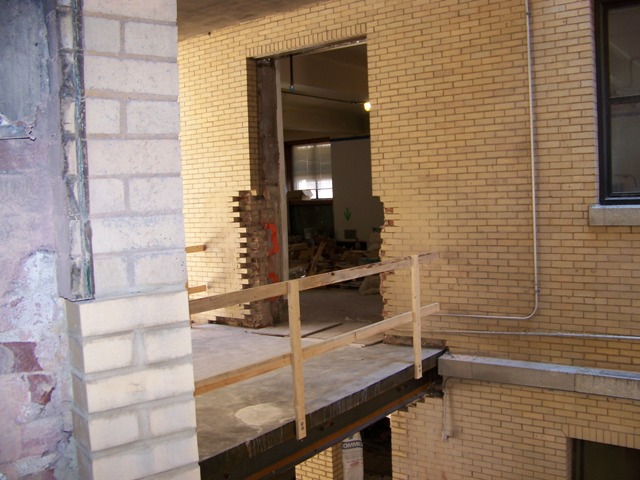
This is one of the new bridges built across what was originally open courtyard space. The photograph, taken on June 29, 2011, looks into the main Children's Library from the new Center for the Reader, built out of former staff workspace. The bridge allows you to walk from the new Atrium directly into the center of the building, one floor beneath the Great Hall, and head in any compass direction: towards new children's or teen rooms, into the exciting innovative experimental technology space called the Creative Experience, or perhaps into the Studio - a massive collection of recorded music, movies, and other media. One of the original windows has been enlarged into a welcoming doorway, and the bridge will eventually be walled with glass, allowing you to look out into the fascinating courtyard architecture for the first time since the building opened. This ground floor is full of new materials, with massive rooms designed to be sleek and light - a contrast to the beautiful, classical rooms on the main floor.
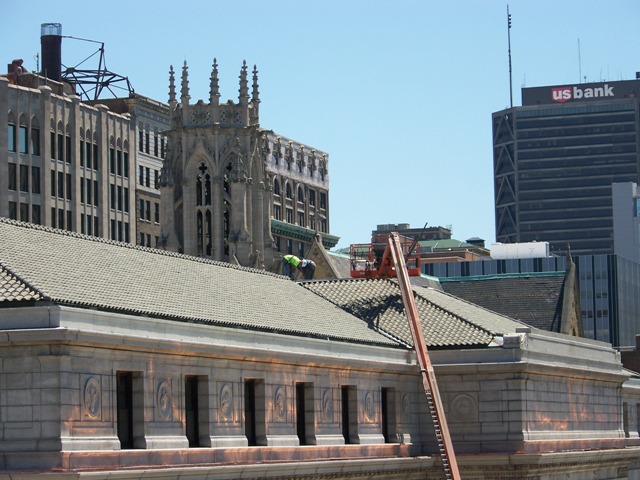
On a rare sunny day at the end of June 2011, workers high atop the building removed the original skylight above the 3rd floor gallery, which had been covered for decades, and replaced it with a new one. St. Louis' remarkable architectural heritage is hinted at in this photograph: the gothic tracery of the tower of Christ Church Episcopal Cathedral soars above the Italian tile roof of Central Library, and the curve of the Shell Building's massive art deco façade shows just to the left of the tower. To its right is a glimpse of the 400 room Jefferson Hotel, which opened in 1904 to welcome visitors to the World's Fair. The photographs documenting the construction of Central Library also show the tower being added to the 1859 Cathedral during 1910-1912.
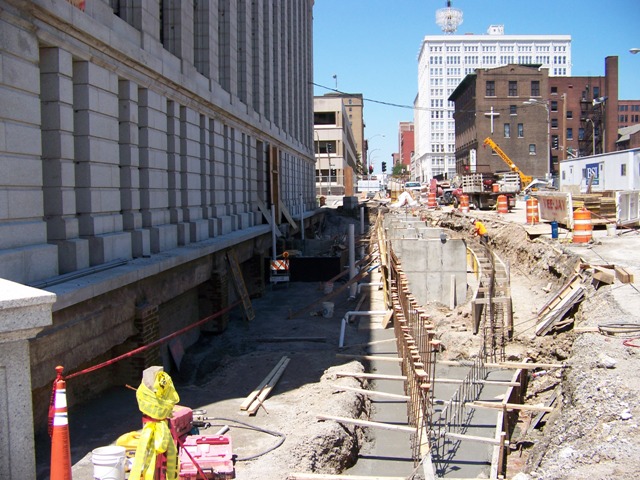
This photograph from June 29, 2011 looks west across the original stack tower wing at the back of the building, facing Locust Street. It shows the foundation for the new Locust Street entrance, which opens into the new Atrium. The rectangular foundation for the new stainless steel canopy can be seen at the center of the photograph, as well as the curved wall of the reflecting pool it will float upon. Compare this photograph with the following rendering of what the new entrance will look like from almost the same angle. Other than the careful restoration and lighting of the historic west, south, and east facades, this is the only visible change to Central Library from the outside.
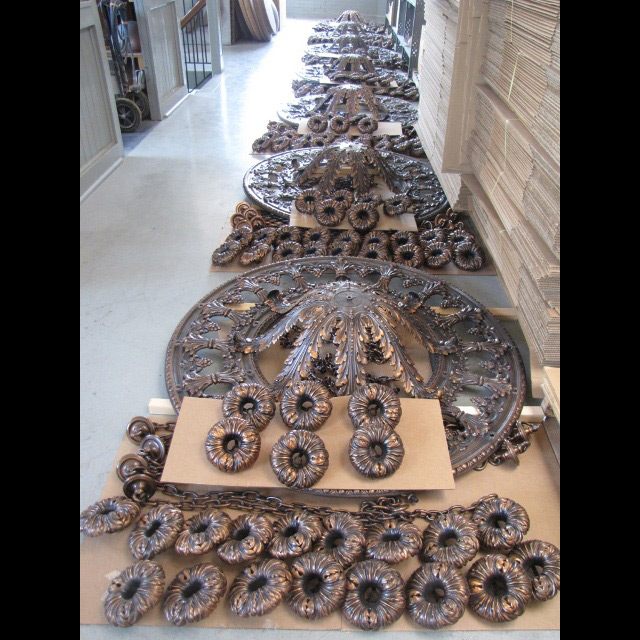
While major construction work was going on inside the building, other elements of the restoration were taking place elsewhere. Here, disassembled pieces of the massive Great Hall chandeliers are being restored at the St. Louis Antique Lighting company. The chandeliers have been taken entirely apart, and each piece cleaned, polished, and coated with a protective lacquer. These chandeliers, chosen specifically by Gilbert, are made of bronze with an unusually high percentage of copper, which gives them their distinctive reddish hue.
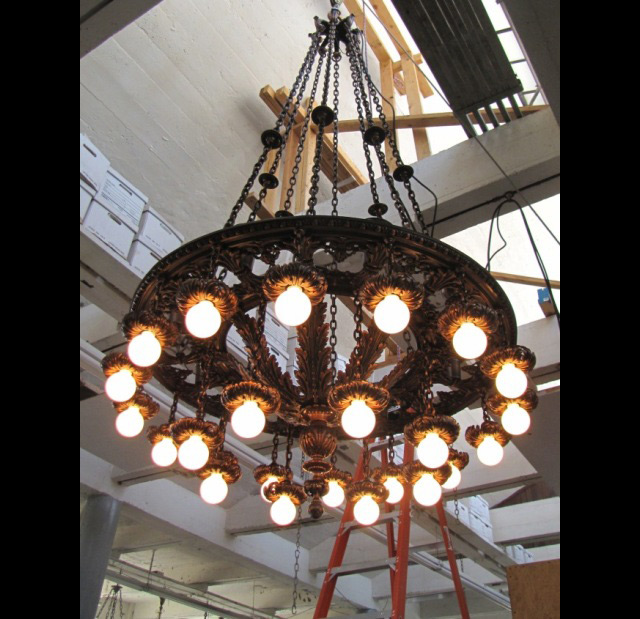
The eight chandeliers were reassembled and completely rewired to support new, energy-efficient light sources that still closely resemble the original 1912 bulbs. LED light sources are concealed in the tops of the chandeliers to highlight the gilt and deep colors of the Great Hall ceiling.
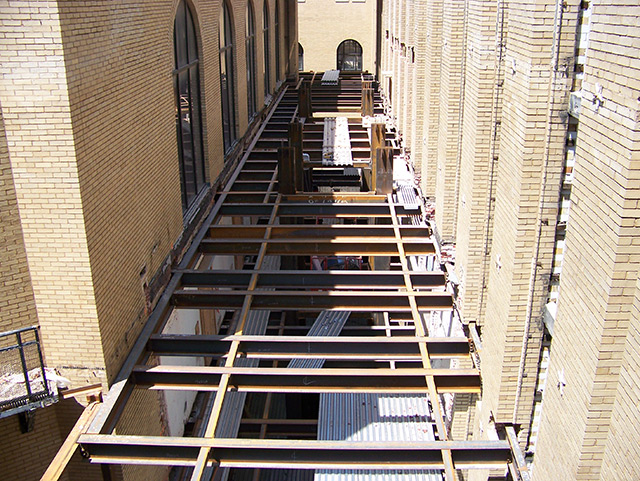
This picture, taken on August 1, 2011 looks west into the courtyard from the top floor of Central Library. The steel frame shown covers the courtyard; there will be three stories of new rooms and spaces housed below this roof. To the left are the massive, arched windows of the Great Hall, which receive full morning and evening sun, and on the right are the window openings of the stack tower. The eight massive columns that jut slightly above the roof level surround shafts for the new elevators, which take patrons from the Atrium to either the Auditorium level, or the Great Hall level.
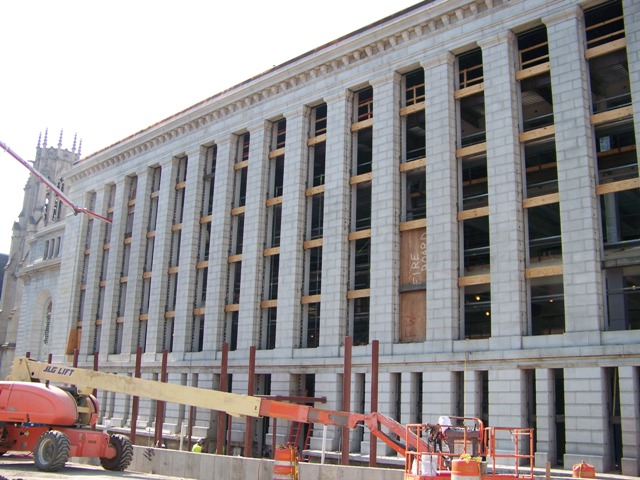
Since for now the interior spaces are largely full of construction scaffolding, it is easier to understand the scale of the new windows and views from the exterior. Here, in a picture taken on August 12th, the original windows have been removed from the huge window openings Gilbert created to light the seven floors of bookcases hidden behind. Replaced with clear glass, anyone in the park or surrounding streets will be able to see through to the multiple floors of activity taking place on the cantilevered "balconies" within. Inside, patrons in the new computer areas, training rooms, browsing areas, and additional spaces will be looking out through these huge windows for the first time.

While much of the collection once housed in the stack tower was relocated into new spaces created throughout Central Library, some collections require special protection. This stack tower space is located on the third main floor of Central Library at the top of the grand stair, where enormous new Genealogy, St. Louis History, and Special Collections rooms have been designed. Rare books and genealogical materials have special storage areas at this level, protecting them from damaging light and other threats. This picture shows rails for compact shelving, which have been sunk into the concrete. In the background, the topmost opening for the atrium ceiling can be seen, partially blocked by scaffolding.
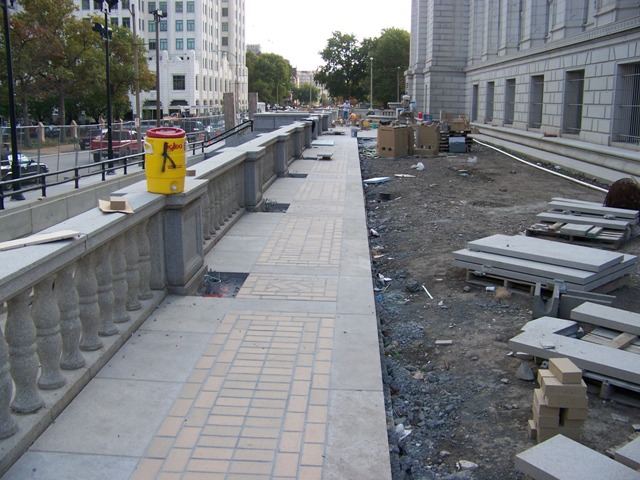
Because of the expense of recreating the elaborate original design, built of limestone and an unusual handmade brick, the Library examined a number of options for replacing the terraces, including simplifying and removing them altogether. Because of very aggressive bidding, and because the terraces are such an important part of the design and civic environment, the Library decided to restore them. The elaborate brick pattern was simplified in a few small details to allow us to use a standard brick size, saving an enormous amount over custom-making a duplicate of the original brick. But you can see the architects and masons are taking great care to restore this beautiful and important feature.

On the main floor, months of work have gone into repairing and restoring the magnificent ceilings, originally designed by Gilbert to represent or re-create several different Renaissance buildings, including Michelangelo's Laurentian Library. Here in the Fine Arts Room artists and plaster craftsmen have recreated and set in place the portions of the ceiling removed decades ago. In this photograph an artist is working 30 feet overhead to recreate the original ceiling finishes using a variety of paints and small brushes.
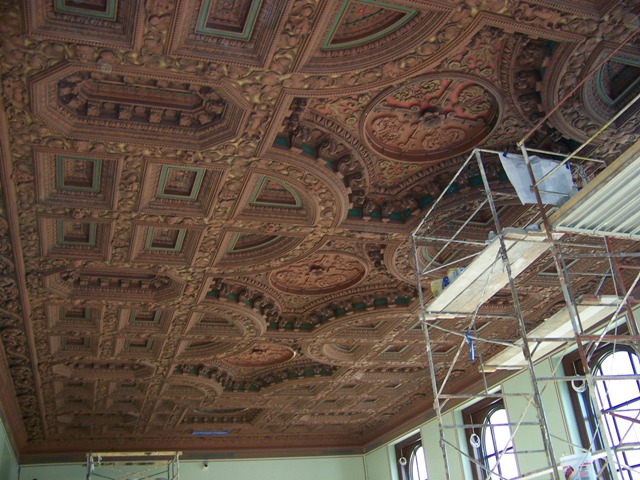
This photograph, taken early in January, 2012, shows the Fine Arts ceiling nearing completion. If you look closely at the nearest enormous round medallion that has been recreated, you will see that the detailed painting is only partially complete. As of mid-February, the unique ceilings in each of the five enormous main rooms of the main floor have been restored. The vaulted and delicately painted ceiling of the Olive Street entry is being studied by restoration experts to determine the best method of restoring its complex figures and colors.
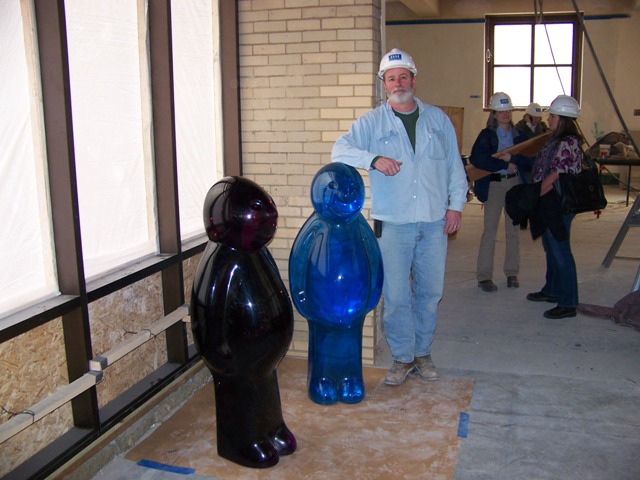
Every aspect of construction has brought unique situations. Here, on one of the newly built glass bridges across the courtyard of Central Library, the Gateway Foundation is providing a series of sculptures to welcome children to the new Children's Library. Known around the world as "Jelly Babies," the sculptures by Mauro Perucchetti are made of cast resin and very heavy. BSI Constructor's foreman has brought the sculptures out of storage and carried them into the building several times so that placement, lighting, and structural issues related to their installation could be addressed. All of the Jelly Babies have been moved back into storage to await permanent installation just before the public opening.

On February 17th, 2012, masons take advantage of the warm weather to work on the enormous terraces that surround Central Library. The complex patterns of limestone and brick designed by Cass Gilbert are being recreated over modern drainage systems and lighting installations. Here the work on the southeast terrace is nearing completion, and the half-circle pattern in front of the west Lion's Fountain is finished.